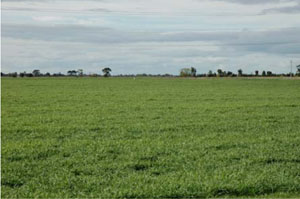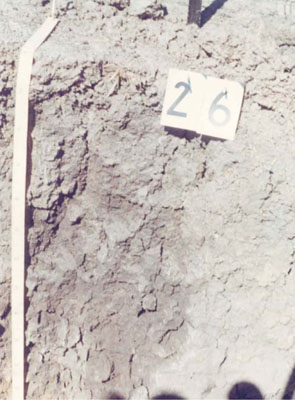IS22
Location: Riverside
Australian Soil Classification: Endocalcareous-Endohypersodic, Massive, Grey VERTOSOL
Northcote Factual Key: Ug5.24
Great Soil Group: grey clay
Soil Type: Murtoa Clay.
General Landscape Description: Terrace flat.
Geology: Quaternary Coonambidgal Formation: fluvial to lacustrine clays and sands

| IS22 Landscape |
Soil Profile Morphology:
Surface Soil
| A1 | 0-5 cm | Dark grey (10YR4/1); medium clay; cracking massive (structureless) surface condition when undisturbed; weak subangular blocky structure; very strong consistence dry; moderately sticky consistence wet; pH 6.3; sharp and smooth boundary to: |  IS22 Profile |
| Subsoil | |||
| B21 | 5-25 cm | Dark grey (10YR4/1); light medium clay; subplastic; moderate coarse prismatic structure; strong consistence dry; moderately sticky consistence wet pH 7.1: | |
| B22 | 25-60 cm | Dark grey (10YR4/1); heavy clay; moderate coarse prismatic structure; weak consistence dry; moderately sticky consistence wet; very few (<2%) hard carbonate segregations; pH 7.2; gradual and smooth boundary to: | |
| B31 | 60-95 cm | Grey (10YR5/1); heavy clay; plastic; moderate coarse subangular structure; very few (<2%) hard carbonate segregations; pH 6.4; gradual boundary to: | |
| B32 | 95-115 cm | Light brownish grey (10YR6/2); heavy clay; plastic; moderate coarse subangular structure; very strong consistence dry; moderately sticky consistence wet; very few (<2%) hard carbonate segregations; pH 6.3; gradual boundary to: | |
| B33 | 115-150 cm | Greyish brown (2.5Y5/2); heavy clay; plastic; strong coarse angular blocky structure; strong consistence dry; moderately sticky consistence wet; very few (<2%) hard carbonate segregations pH 5.9. | |
Chemical and Physical Analysis:
Horizon | Sample Depth cm | pH | EC dS/m | Sodium Chloride % | Exchangeable Calcium cmol-/kg | Exchangeable Magnesium cmol-/kg | Exchangeable Potassium cmol-/kg | Exchangeable Sodium cmol-/kg | Total Nitrogen % | Organic Carbon % | Exchangeable Acidity cmol-/kg | Bulk Density | Permanent Wilting Point -1500okPa | Coarse Sand % | Fine Sand % | Silt % | Clay % | |
H2O | CaCl2 | |||||||||||||||||
A1 | 0–5 | 6.3 | 5.4 | 0.12 | 0.02 | 7.2 | 10 | 0.7 | 0.8 | 0.13 | 1.03 | 8 | 1.28 | 22.7 | 1 | 27 | 27 | 44 |
B21 | 5–25 | 7.1 | 0.14 | 0.03 | 10.1 | 16.2 | 0.8 | 2.7 | 0.09 | 8.6 | 1.3 | 21.1 | 0 | 14 | 20 | 65 | ||
B22 | 25–60 | 7.2 | 0.53 | 0.11 | 9.8 | 16.2 | 0.7 | 4.2 | 0.06 | 0.54 | 6.4 | 1.39 | 23.8 | 0 | 13 | 23 | 61 | |
B23 | 60–95 | 6.4 | 0.14 | 0.14 | 9.2 | 15.9 | 0.6 | 5.2 | 0.04 | 0.34 | 6.3 | 1.3 | 21.9 | 0 | 12 | 24 | 63 | |
B31k | 95–115 | 6.3 | 0.74 | 0.12 | 7.5 | 13 | 0.6 | 5.2 | 0.03 | 0.2 | 7.5 | 21.4 | 1 | 13 | 24 | 61 | ||
B32 | 115–150 | 5.9 | 0.86 | 0.17 | 6.9 | 12.4 | 0.6 | 4.5 | 0.03 | 0.15 | 7.5 | 20.7 | 0 | 14 | 23 | 62 | ||
Management Considerations:
- Cracking clay soils with self-mulching properties
- Plant available water capacity (PAWC) is considered to be low (estimated at 55 mm). This is based on available laboratory data and assumes an effective rooting depth of 30 cm. The high level of soluble salts in the subsoil will restrict effective rooting depth.
- When the soil is dry, heavy rains will move down soil cracks. This rapid recharge can be valuable for the survival of plants near wilting. When wet, the soil will swell and further infiltration of water will be relatively slow.
- Tillage of cracking clay soils should be avoided if the soil is wet (ie. wetter than the plastic limit). At such a moisture condition, excessive tillage, trafficking or overstocking can result in structural degradation (eg. compaction, smearing) occurring. Ideally, tillage should take place on clay soils such as these when the soil is drier than the plastic limit, down to at least the tillage depth
- The level of soluble salts is high in the upper subsoil and becomes very high from 55cm depth.
Profile Described By: John Martin, Nabil Badawy, Ron Cawood, Geoff Pope, John Galea, John Turner (1970).
Reference: "Major Agricultural Soils of the Wimmera Irrigation Area". John Martin, Mark Imhof, Lourey Ruth, Rob Nink, Karen DePlater, Paul Rampant, Sonia Thompson, S. Alexander. Department of Natural Resources and Environment, Victoria. 1996.


